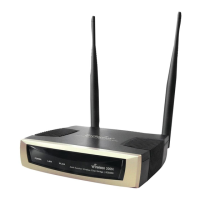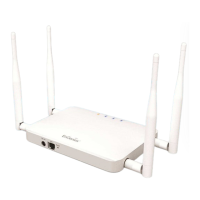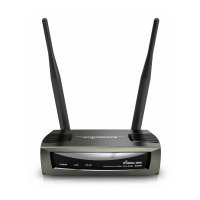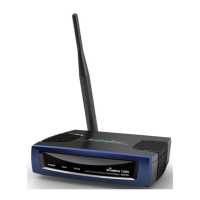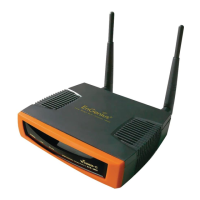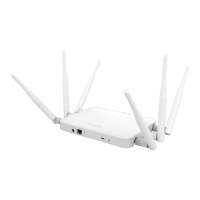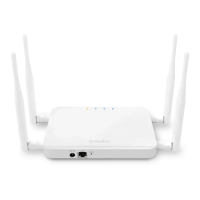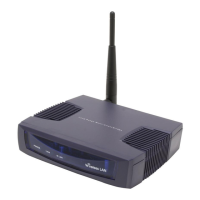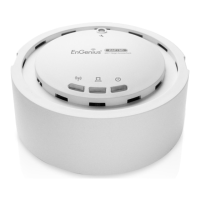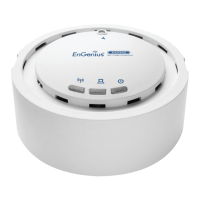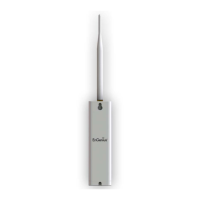Do you have a question about the EnGenius ECW230 and is the answer not in the manual?
Overview of the Access Point's features, capabilities, and intended use cases.
Minimum system requirements for configuring the device, including computer and OS specifications.
Detailed technical specifications covering standards, interfaces, power, modes, and management features.
Description of the physical ports, indicators, and dimensions of the Access Point device.
Instructions for configuring TCP/IPv4 connection settings on Windows XP, 7, 8, and 10 for device setup.
Steps for connecting Ethernet cables, power adapter, and PoE for hardware setup.
Guidance on attaching the Access Point to a wall or ceiling using provided hardware.
Information on default IP address, username, and password for initial access.
Steps to access and log into the device's web-based configuration interface.
Explanation of how the AP functions as a central connection point for wireless clients.
Details on saving and reverting settings and viewing device information.
How to view current operating mode and general system information like MAC address.
Information on viewing client connection lists and WDS link status.
Monitoring CPU loading, traffic, and connection status in real-time.
Configuration options for the device's IP address, subnet mask, and gateway settings.
Configuration of STP to prevent network loops and its operational parameters.
General wireless configuration, including device name and band steering options.
Features for steering clients between 2.4GHz and 5GHz bands for optimal performance.
Configuration of wireless network parameters like operation mode, channel, and data rate.
Settings for securing wireless networks using WEP, WPA2-PSK, and WPA2-Enterprise.
Method to allow or deny network access based on client MAC addresses.
Regulating traffic flow and setting bandwidth limits for downloads and uploads.
Enabling seamless roaming for mobile clients between Access Points.
Configuration for creating separate guest networks for visitors.
Assigning VLAN tags to packets for network segmentation.
Configuration for Simple Network Management Protocol (SNMP) for network monitoring.
Options for Command Line Interface (CLI), SSH, and HTTPS for device management.
Setting up email notifications for system events and alerts.
Configuring the device's internal clock and time zone settings.
Scheduling automatic device reboots for maintenance.
Creating schedules to enforce wireless access rules or restrict usage.
Network diagnostic tools like Ping and Traceroute for troubleshooting.
Implementing speed tests and controlling LED indicator status.
Discovering network devices and their operational details.
Changing the administrator username and password for device access.
Process for upgrading the Access Point's firmware to the latest version.
Saving and restoring device configurations to default or user settings.
Backing up and restoring custom user configurations.
Viewing system logs and configuring remote logging functions.
Options for rebooting the device or restoring factory/user default settings.
Steps for installing APs managed by an EnGenius Wireless Management Switch.
Guide for installing and managing APs using the EnGenius ezMaster software.
FCC compliance statement regarding radio frequency interference.
Industry Canada compliance statement for radio interference.
CE compliance statement for European Union regulations.
Overview of the Access Point's features, capabilities, and intended use cases.
Minimum system requirements for configuring the device, including computer and OS specifications.
Detailed technical specifications covering standards, interfaces, power, modes, and management features.
Description of the physical ports, indicators, and dimensions of the Access Point device.
Instructions for configuring TCP/IPv4 connection settings on Windows XP, 7, 8, and 10 for device setup.
Steps for connecting Ethernet cables, power adapter, and PoE for hardware setup.
Guidance on attaching the Access Point to a wall or ceiling using provided hardware.
Information on default IP address, username, and password for initial access.
Steps to access and log into the device's web-based configuration interface.
Explanation of how the AP functions as a central connection point for wireless clients.
Details on saving and reverting settings and viewing device information.
How to view current operating mode and general system information like MAC address.
Information on viewing client connection lists and WDS link status.
Monitoring CPU loading, traffic, and connection status in real-time.
Configuration options for the device's IP address, subnet mask, and gateway settings.
Configuration of STP to prevent network loops and its operational parameters.
General wireless configuration, including device name and band steering options.
Features for steering clients between 2.4GHz and 5GHz bands for optimal performance.
Configuration of wireless network parameters like operation mode, channel, and data rate.
Settings for securing wireless networks using WEP, WPA2-PSK, and WPA2-Enterprise.
Method to allow or deny network access based on client MAC addresses.
Regulating traffic flow and setting bandwidth limits for downloads and uploads.
Enabling seamless roaming for mobile clients between Access Points.
Configuration for creating separate guest networks for visitors.
Assigning VLAN tags to packets for network segmentation.
Configuration for Simple Network Management Protocol (SNMP) for network monitoring.
Options for Command Line Interface (CLI), SSH, and HTTPS for device management.
Setting up email notifications for system events and alerts.
Configuring the device's internal clock and time zone settings.
Scheduling automatic device reboots for maintenance.
Creating schedules to enforce wireless access rules or restrict usage.
Network diagnostic tools like Ping and Traceroute for troubleshooting.
Implementing speed tests and controlling LED indicator status.
Discovering network devices and their operational details.
Changing the administrator username and password for device access.
Process for upgrading the Access Point's firmware to the latest version.
Saving and restoring device configurations to default or user settings.
Backing up and restoring custom user configurations.
Viewing system logs and configuring remote logging functions.
Options for rebooting the device or restoring factory/user default settings.
Steps for installing APs managed by an EnGenius Wireless Management Switch.
Guide for installing and managing APs using the EnGenius ezMaster software.
FCC compliance statement regarding radio frequency interference.
Industry Canada compliance statement for radio interference.
CE compliance statement for European Union regulations.
| 2.4 GHz | Yes |
|---|---|
| MIMO type | Multi User MIMO |
| Modulation | 16-QAM, 64-QAM, 256-QAM, 1024-QAM, BPSK, CCK, QPSK |
| Frequency band | 2.4 - 2.482, 5.15 - 5.25, 5.25 - 5.35, 5.47 - 5.725, 5.725 - 5.85 GHz |
| Transmitting power | 23 dBmW |
| Fit AP mode features | Mesh networking |
| Networking standards | IEEE 802.11a, IEEE 802.11ac, IEEE 802.11ax, IEEE 802.11b, IEEE 802.11e, IEEE 802.11g, IEEE 802.11n, IEEE 802.1D, IEEE 802.1Q, IEEE 802.3, IEEE 802.3ab, IEEE 802.3at, IEEE 802.3u |
| Virtual LAN features | Tagged VLAN |
| Spread spectrum method | OFDMA, DSSS, OFDM |
| Ethernet LAN data rates | 10, 100, 1000 Mbit/s |
| Maximum data transfer rate | 2400 Mbit/s |
| Maximum data transfer rate (2.4 GHz) | 1148 Mbit/s |
| USB 2.0 ports quantity | 0 |
| Ethernet LAN (RJ-45) ports | 1 |
| Power consumption (max) | 19.5 W |
| Antenna type | Internal |
| Antenna features | Integrated antenna |
| Antennas quantity | 8 |
| Antenna direction type | Omni-directional |
| Antenna gain level (max) | 3 dBi |
| Placement | Ceiling, Wall |
| Product color | White |
| Cable lock slot type | Kensington |
| Security algorithms | WPA3, 64-bit WEP, 128-bit WEP, 152-bit WEP, SSH, WPA, WPA-TKIP, WPA2, WPA2-AES, WPA2-PSK |
| Service Set Identifier (SSID) features | Multiple SSIDs |
| Storage temperature (T-T) | -40 - 80 °C |
| Operating temperature (T-T) | 0 - 40 °C |
| Harmonized System (HS) code | 85176990 |
| Width | 210 mm |
|---|---|
| Height | 33.2 mm |
| Weight | 597 g |

